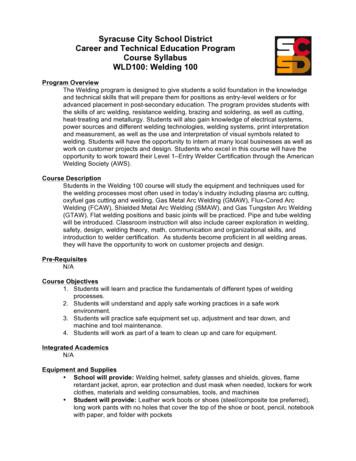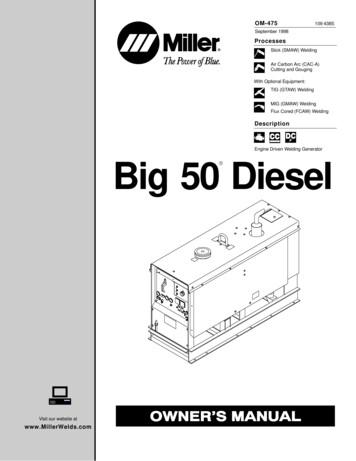Ower And Recreation Equipment Welding
DESCRIPTIONower and recreationCONTESTequipmentWeldingSECONDARY / POST-SECONDARYSECONDARY / POST-SECONDARY
Table of Contents1 THE ESSENTIAL SKILLS FOR CAREERS IN THE SKILLED TRADES ANDTECHNOLOGY . 32 CONTEST INTRODUCTION . 33 CONTEST DESCRIPTION . 44 EQUIPMENT, MATERIAL, CLOTHING . 55 SAFETY REQUIREMENTS . 76 ASSESSMENT . 87 CONTEST SPECIFIC RULES. 88 ADDITIONAL INFORMATION . 99 NATIONAL TECHNICAL COMMITTEE MEMBERS . 10SCNC 2021 – Contest Description10 – Welding Secondary and Post-SecondaryPage 2 to 10
1THE ESSENTIAL SKILLS FOR CAREERS IN THE SKILLED TRADES ANDTECHNOLOGYSCC is currently working with Employment and Social Development Canada(ESDC) in order to bring awareness to the importance of Essential Skills that areabsolutely crucial for success in the workforce. Part of this ongoing initiativerequires the integration and identification of Essential Skills in contestdescriptions, projects, and project documents. The next phase and veryimportant aspect of our Essential Skills (ES) initiative is to provide an ES reportcard to each competitor at the Skills Canada National Competition. Thepurpose of the ES report card is to inform the competitor about their currentlevel of essential skills based on their competition scores. With this knowledge,the competitor will be made aware which essential skill may requireimprovement. Full implementation is expected in the next Skills Canada NationalCompetition.The following 9 skills have been identified and validated as key essential skillsfor the workplace in the legend below:1Numeracy, 2Oral Communication, 3Working with Others, 4ContinuousLearning, 5Reading Text, 6Writing, 7Thinking, 8Document Use, 9DigitalThese essential skills have been identified in section 2.4 and/or 3.2 of yourContest Description and if applicable, in your Project and all other supportingproject documents.22.1CONTEST INTRODUCTIONDescription of the associated work role(s) or n/careers/construction/welding/2.2Purpose of the challengeAssess the contestant’s ability in the trade of welding. Contestants mustdemonstrate their knowledge in reading plans and interpreting welding symbols,and their mastery of the main welding processes used in today’s industry.2.3Contest duration for Post-secondary14 hours: spread over two days, 8 hours the first day and 6 hours the secondday.Contest duration for Secondary12 Hours: spread over two days, 6 hours a day.2.4Skills and knowledge to be testedThe assembly and welding work will be assessed based on the technical plansand welding processes specified in the projects.SCNC 2021 – Contest Description10 – Welding Secondary and Post-SecondaryPage 3 to 10
33.1CONTEST DESCRIPTIONThe documents that will be provided and the dates when they will becomeavailable to the competitors.DOCUMENTProject3.2DATE POSTED ON THE WEB SITENovember 2020Tasks that may be performed during the contest.3.2.1 Theoretical elementsThe contest’s theoretical portion is limited to the knowledge required to executethe practical work. These elements are integrated into the contest for evaluationpurposes, and include the following skills: Interpretation of plans (engineering drawing)8 Interpretation of welding symbols8 Knowledge of base metals and filler metals7 Adjustment of welding machines1 Workplace safety rules5 Noteso All measurements are shown in metrico All instructions and plans will be provided in English and French.3.2.2 Practical tasks3.2.2.1 Secondary Shielded metal arc welding (SMAW, mild steel)) Gas metal arc welding (GMAW, mild steel) Flux core (FCAW) 3.2.2.2 Post-secondary Shielded metal arc welding (SMAW, mild steel) Gas metal arc welding (GMAW, mild steel) Flux cored arc welding (FCAW, mild steel) Gas tungsten arc welding (GTAW, mild steel, stainless steel andaluminum)SCNC 2021 – Contest Description10 – Welding Secondary and Post-SecondaryPage 4 to 10
3.2.3 TasksThe following types of joints and positions may be included.SecondaryPost-secondaryAssemble and weld mild steel structures:SMAW, GMAWSMAW, GMAW, FCAWPlate: 1G, 2G, 3G,Plate: 1G, 2G, 3G, 4GFillet Weld: 1F, 2F, 3F,4F, 5FFillet Weld: 1F, 2F, 3F, 4F, 5FPipe: 1G, 2G, 3G, 5G,6GPipe may or may not be includedAssemble and weld stainlesssteel, carbon steel and aluminumstructures:GTAW / GTAW PulsePlate: 1G, 2G, 3G, 4GFilet: 1F, 2F, 3F, 4F, 5FPipe: 1G, 2G, 3G, 5G,6GEssential Skills – 1Numeracy, 5Reading Text, 7Thinking (significant use of memory)8Document Use.44.1EQUIPMENT, MATERIAL, CLOTHINGEquipment and materials provided by Skills/Compétences Canada CeriumE3 and zirconium types electrodesCups and colletsGas lenses will be provided: 2.4 and 3.2 Ø mm.Tungsten sharpenerPlans and instructionsSet or practice materialsAll basic materials required to complete projectsFoot control (pedal) for the GTAW processAll filler materialsAluminum solvent (cleaner) will be providedAngle grinder 4 1/2" 10 amp' - Stanley/Dewalt model: DWE4011cordlessGrinding disc 1/4'', 1/8'', 3/32'' - Stanley/DewaltWelding machines and accessories for Post-Secondary competition:Lincoln Electric Square Wave TIG 200 AC/DC, with foot pedal control andPower MIG 360 Multi Process.Welding machines and accessories for Secondary competition: PowerMIG 360 MP Multi Process Units.All equipment can be view at www.lincolnelectric.caCompetitor can use any function on the machines. Competitor will beorientated on the basic capability of the machine.SCNC 2021 – Contest Description10 – Welding Secondary and Post-SecondaryPage 5 to 10
4.1.1 Secondary materials Low carbon steelPlate thickness: 3 – 9.5 mmPipe wall thickness: 3.56 – 6.02 mmPipe Diameter: 42.2 – 114.3 mmFiller materialso SMAW E4918, 2.4 and 3.2 mmo SMAW E4310, 3.2 mm or E4311, 3.2 mmo GMAW ISO B-G49A SC G6 (ER49S-6), 0.9 mmShielding gaso GMAW 75% Ar 25% CO24.1.2 Post-secondary materials 4.2Low carbon steelo Plate thickness: 3 mm - 9.5 mmo Pipe wall thickness: 3.56 mm – 6.02 mmo Diameter: 42.2 mm – 114.3 mmStainless steel: 1.6 mm -3.2 mmAluminum: 3. mm to 3.2mmFiller materialso SMAW E4918, 2.4 mm and 3.2 mmo SMAW E4310, 3.2 and 2.5 mm or E4311, 3.2 and 2.5 mmo GMAW ISO B-G49A SC G6 (ER49S-6), 0.9 mmo FCAW E491T-9-CH, 1.2 mmo GTAW ISO B-G49A SC G3 (ER49S-3),1.6 and 2.4 and 3.2 mmo GTAW ER308, 2.4 and 1.6 mm ando GTAW ER4043, 2.4 and 3.2 mmShielding gaso GMAW / FCAW 75% Ar 25% CO2o GTAW ArgonEquipment and materiel provided by the competitor TungstenHelmet, #10, 11 or 12 lensSpeed lenses (optional)Soap Stone / markersCentre punchScriberCold chisel12” combination square (45 / 90 )Welding gaugeSCNC 2021 – Contest Description10 – Welding Secondary and Post-SecondaryPage 6 to 10
Chipping hammerSteel and stainless steel wire brushesDividersProtractor gaugeDigital level or levelBall peen hammerAll-purpose pliers / side cuttersVice grip AND C-CLAMPSMagnet bracketFiles/ with handlesWedgesWater spray bottle (e.g. Windex bottle)Wrap-A-RoundHacksaw (Stanley 20-807W mini)Measuring tape metricMetric rulerMagnetic work light.Trigger clampsPicksFlashlightGrinders are not permitted: Grinders will be provided in a grindingboothCOMPETITORS WILL BE REQUIRED TO USE THE MATERIAL ANDEQUIPMENT PROVIDED BY SCC. ALL OTHER MATERIAL AND EQUIPMENTWILL BE REMOVED FROM THE SKILL AREA.4.2.1 Toolboxes GuidelinesOne of the objectives of SCC is the sustainability of the Competition. As a result,the toolboxes brought by Competitors will be restricted to the items in section4.2 only. There is no exception to this rule. If the Competitor brings other tools,they will be removed and will not be used during the competition.4.3Required clothing (Provided by the competitor) 55.1Appropriate work clothes (no synthetics clothing’s or hoodies)SAFETY REQUIREMENTSSafety workshopUpon arrival at the Skill area, Competitors will participate in a Safety workshopand they will be expected to work and maintain a safe working area during thecompetition. Any Competitor breaking any health, safety and environment rules,may be required to undertake a second safety workshop, this will not affect theCompetitor’s competition time.SCNC 2021 – Contest Description10 – Welding Secondary and Post-SecondaryPage 7 to 10
5.2Personal protective equipment (PPE) provided by Skills/Compétences Canada 5.3Hearing protection – McCordickSafety glasses – McCordickRubber gloves – McCordickLeather work gloves – McCordickClear face shield - McCordickPersonal protective equipment (PPE) provided by competitors: CSA approved safety shoes Welding helmet Welder’s glovesNote: Contestants who do not have the required protective gear will not beallowed to participate in the contest6ASSESSMENT6.1 Point breakdownPOINT BREAKDOWNSECONDARYDay 1 – Project (6 hours)Day 2 – Project (6 hours)POST-SECONDARYDay 2 – Project and Aluminum (3 hours)Day 2 – Project and Stainless Steel (3 hours)Day 1 – Project (8 hours)7/1005050262450CONTEST SPECIFIC RULESContest specific rules cannot contradict or take priority over the CompetitionRules. They do provide specific details and clarity in areas that may vary fromcontest to contest. Any additional contest rules will be reviewed during thecompetitors orientation.TOPIC/TASKUse of technology personal laptops,tablets and mobilephonesCONTEST SPECIFIC RULE Competitors are not allowed to bringpersonal laptops tablets or mobile phonesinto the skill areaSCNC 2021 – Contest Description10 – Welding Secondary and Post-SecondaryPage 8 to 10
88.1ADDITIONAL INFORMATIONInterpreterIf a competitor requires the help of an interpreter once onsite during thecompetition, the Skills/Compétences Canada Provincial/Territorial offices mustadvise Skills/Compétences Canada National Secretariat a minimum of 1 monthprior to the competition or this service might not be guaranteed.8.2Ties 8.3Tiebreaker #1: The competitor with the highest score in the first project,will be declared the winner.Tiebreaker #2: The competitor with the highest mark in the open groveweld or welds on day 1 project will be declared the winner.Tiebreaker #3: The Competitor with the highest score on second projectwill be declared the winner.Test Project change at the CompetitionWhere the Test Project has been circulated to Competitors in advance, NTCshall change a maximum of 30% of the work content. Please refer to theCompetition Rules8.4Competition rulesRefer to the Competition rules of the Skills Canada National Competition whichcan be found on our website.SCNC 2021 – Contest Description10 – Welding Secondary and Post-SecondaryPage 9 to 10
9NATIONAL TECHNICAL COMMITTEE MEMBERSMember OrganizationAlberta - ChairPrince Edward Island - Co-ChairQuébecOntarioNew BrunswickSaskatchewanManitobaYukonNova ScotiaBritish ColombiaNameDan LyngePatrick CheverieMartin DaignaultJosh HydeAdam SteadDevin MilliganToby PuntonSky PearsonStephen StewartPat McGurkContact the Skills/Compétences Canada national secretariat for any questionsor concerns: Nathalie Maisonneuve (nathaliem@skillscanada.com).SCNC 2021 – Contest Description10 – Welding Secondary and Post-SecondaryPage 10 to 10
10 – Welding Secondary and Post-Secondary Page 5 to 10 3.2.3 Tasks The following types of joints and positions may be included. Secondary Post-secondary Assemble and weld mild steel structures: SMAW, GMAW SMAW, GMAW, FCAW Plate: 1G, 2G, 3G, Fillet Weld: 1F,
6.3 Mechanised/automatic welding 114 6.4 TIG spot and plug welding 115 7 MIG welding 116 7.1 Introduction 116 7.2 Process principles 116 7.3 Welding consumables 130 7.4 Welding procedures and techniques 135 7.5 Mechanised and robotic welding 141 7.6 Mechanised electro-gas welding 143 7.7 MIG spot welding 144 8 Other welding processes 147 8.1 .
the welding processes most often used in today's industry including plasma arc cutting, oxyfuel gas cutting and welding, Gas Metal Arc Welding (GMAW), Flux-Cored Arc Welding (FCAW), Shielded Metal Arc Welding (SMAW), and Gas Tungsten Arc Welding (GTAW). Flat welding positions and basic joints will be practiced. Pipe and tube welding
the limited depth of underwater welding. Welding equipment transformed from manual welding to underwater automatic welding. The efficient and low-cost underwater welding was achieved[7]. In order to study the automatic welding technology under larger deep-water environment, the underwater automatic welding system was designed in this paper. The
3. Classification of Underwater Welding Underwater welding may be divided into two main types: a) Wet welding b) Dry welding Fig. 3.1 Classification of underwater welding 3.1 Wet welding 3.1.1. Wet welding with coated electrode Wet welding is performed at ambient pressure with the welder-diver in the water and no physical barrier
seam butt welding resistance butt welding flash butt welding resistance butt welding shielded unshielded other process plasma laser resistance butt welding inert gas welding submerged arc welding atomic hydrogen shielded metal arc welding (coated electrode) esepl w w w . e u r e k a e l e c t r o d e s .
north raise a high-quality, high-yielding sunflower variety, PAN 7351. BOTTOM: Coffee, a high value export . "subsistence" — remain chroni-cally poor, reflecting the weak state of the agriculture sector. . Upland Rice MASINDI Upland Rice Sun ower Maize Cotton Sesame APAC Sun ower Cotton Sesame LIRA Sun ower Cotton Sesame KAMULI Maize
Air Carbon Arc (CAC-A) Cutting and Gouging TIG (GTAW) Welding Stick (SMAW) Welding Engine Driven Welding Generator With Optional Equipment: MIG (GMAW) Welding Flux Cored (FCAW) Welding. Miller Electric manufactures a full line of welders and welding related equipment.
There are numerous welding processes including arc welding, electron beam welding, friction welding, laser welding, and resistance welding. This article will concentrate on arc welding, which is the most common technique used to join most steels. Factors affecting weld quality will be discussed and how to avoid common weld defects will be .























